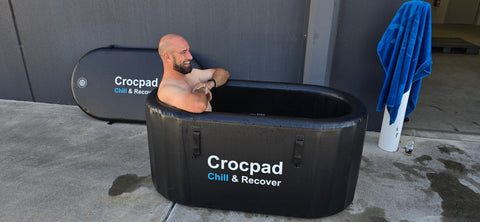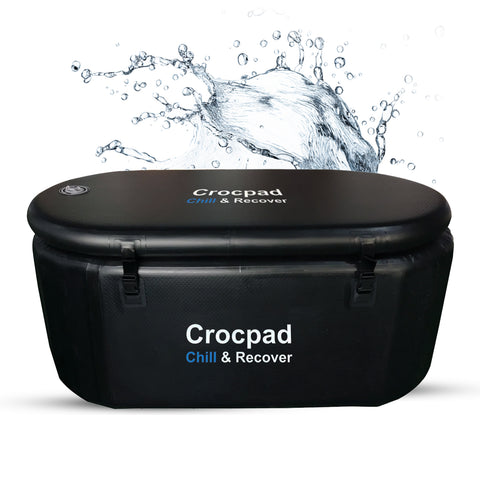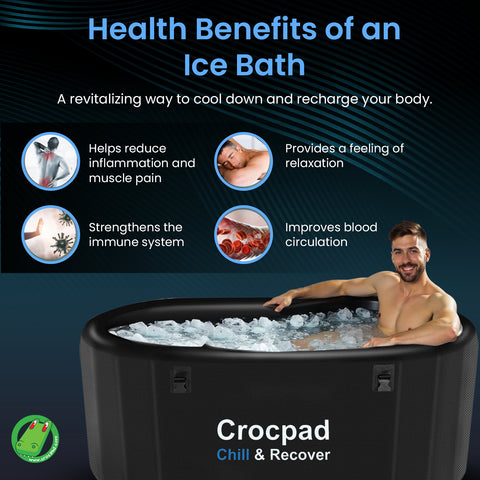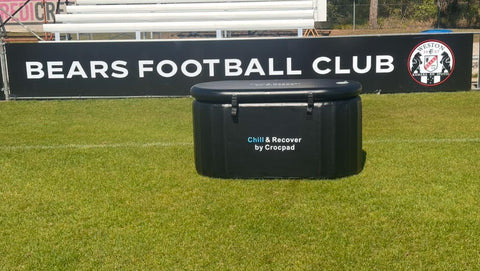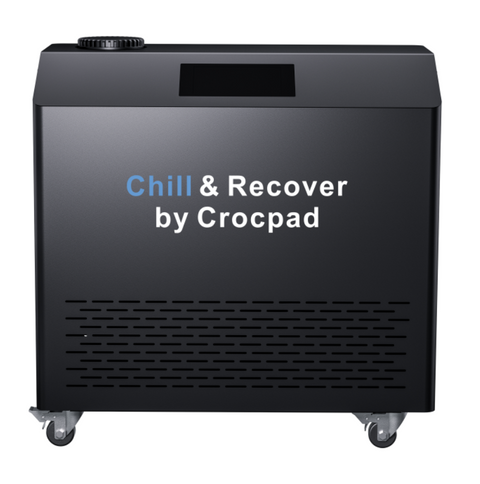In the world of fitness and wellness, recovery often takes a backseat to the thrill of performance. But what if we told you that one simple, chilly practice could revolutionize your post-workout routine? Enter ice baths, the surprising recovery method that's gaining traction among athletes and wellness enthusiasts alike. As temperatures drop, so do inflammation levels and muscle soreness, leading to faster healing and enhanced overall well-being. Beyond physical recovery, immersing yourself in icy waters can invigorate your mind, boost your mood, and elevate your resilience. Whether you're a seasoned athlete or just starting your fitness journey, the benefits of ice baths may be the cool solution you didn't know you needed. Dive in with us as we explore the transformative effects of this frosty approach to wellness and uncover why it’s time to embrace the ice!
Cold therapy, also known as cryotherapy, has long been revered for its therapeutic benefits, dating back to ancient civilizations that utilized cold water for medicinal purposes. Modern science has delved deeper into the mechanisms at play, revealing that exposure to cold temperatures can significantly reduce inflammation, a key factor in muscle recovery. When you immerse your body in ice-cold water, the blood vessels constrict, reducing blood flow to the affected areas. This vasoconstriction helps to decrease swelling and inflammation, allowing for a more rapid recovery process.
Furthermore, cold therapy triggers a process known as thermogenesis, where the body generates heat to maintain its core temperature. This process not only burns calories but also stimulates the release of endorphins, the body's natural painkillers. Endorphins help to alleviate pain and contribute to an overall sense of well-being. Additionally, the cold shock stimulates the production of norepinephrine, a neurotransmitter that plays a critical role in attention, focus, and mood regulation.
Recent studies have shown that cold therapy can also enhance the body's antioxidant defense system. The exposure to cold stress prompts the body to produce more antioxidants, which help to neutralize free radicals and reduce oxidative stress. This can lead to improved cellular health and a stronger immune system. Overall, the scientific underpinnings of cold therapy highlight its potential as a powerful tool for recovery and wellness.
The physical benefits of ice baths are numerous and well-documented, making them a popular recovery method among athletes and fitness enthusiasts. One of the most significant advantages is the reduction of muscle soreness. After an intense workout, muscles can become inflamed and sore due to microscopic tears and the accumulation of lactic acid. Ice baths help to mitigate this soreness by reducing inflammation and flushing out metabolic waste products from the muscles.
Another critical benefit is the accelerated healing of injuries. Cold therapy can be particularly effective for treating acute injuries such as sprains, strains, and bruises. By reducing inflammation and numbing the affected area, ice baths can help to alleviate pain and prevent further tissue damage. This allows for a quicker return to training and physical activity. Moreover, regular use of ice baths can improve overall muscle function and endurance, as the body becomes more adept at managing inflammation and recovering from exertion.
Ice baths also promote better sleep quality, which is essential for recovery and overall health. The cold exposure helps to lower the body's core temperature, which can enhance the onset and quality of sleep. Improved sleep allows for more effective muscle repair and regeneration, leading to better performance and reduced risk of injury. By incorporating ice baths into your routine, you can enjoy a holistic approach to physical recovery that supports long-term wellness.
Beyond the physical advantages, ice baths offer a range of mental health benefits that can enhance your overall well-being. One of the most notable effects is the reduction of stress and anxiety. The cold shock of an ice bath triggers the release of norepinephrine, a hormone and neurotransmitter that helps to improve mood and reduce stress levels. This can lead to a heightened sense of calm and relaxation, making it easier to manage daily stressors.
Additionally, ice baths can boost mental resilience and enhance your ability to cope with challenging situations. The initial discomfort of immersing yourself in icy water requires mental fortitude and discipline. Over time, this practice can help to build mental toughness, as you learn to embrace and overcome the discomfort. This increased resilience can translate to other areas of your life, empowering you to face obstacles with greater confidence and determination.
Ice baths can also improve focus and concentration. The cold exposure stimulates the production of norepinephrine, which plays a crucial role in attention and cognitive function. This can lead to improved mental clarity and enhanced cognitive performance. By incorporating ice baths into your routine, you can enjoy not only physical recovery but also a sharper, more focused mind. The mental health benefits of ice baths make them a valuable addition to any wellness regimen.
Incorporating ice baths into your routine can be a simple and effective way to enhance your recovery and well-being. To start, you will need a bathtub or a large container that can hold enough water to fully immerse your body. Fill the tub with cold water and add ice until the temperature reaches between 50 to 59 degrees Fahrenheit (10 to 15 degrees Celsius). This range is optimal for achieving the therapeutic benefits of cold therapy without causing harm.
Begin by gradually acclimating your body to the cold water. Start with shorter durations, such as two to three minutes, and gradually increase the time as you become more comfortable. Aim for a total immersion time of 10 to 15 minutes for maximum benefits. It's important to listen to your body and avoid staying in the ice bath for too long, as prolonged exposure can lead to hypothermia or other adverse effects.
For best results, incorporate ice baths into your routine after intense workouts or physical activity. This will help to reduce muscle soreness and inflammation, promoting faster recovery. Additionally, you can use ice baths as a regular part of your wellness regimen, even on rest days, to enjoy the mental health benefits and improve overall well-being. Consistency is key, so aim to include ice baths in your routine at least two to three times per week.
Despite the growing popularity of ice baths, there are several myths and misconceptions that can deter people from trying this recovery method. One common myth is that ice baths are only for professional athletes. In reality, anyone can benefit from cold therapy, regardless of their fitness level. Ice baths can help to reduce muscle soreness, improve recovery, and enhance overall well-being, making them a valuable tool for anyone looking to optimize their health.
Another misconception is that ice baths are dangerous and can cause harm. While it's true that prolonged exposure to extremely cold temperatures can be harmful, ice baths are generally safe when done correctly. It's important to follow recommended guidelines, such as limiting immersion time to 10 to 15 minutes and monitoring the water temperature. By taking appropriate precautions, you can safely enjoy the benefits of ice baths without risking your health.
Some people believe that ice baths are a one-size-fits-all solution for recovery. However, the effectiveness of cold therapy can vary depending on individual factors such as fitness level, injury type, and personal preferences. It's essential to listen to your body and adjust your ice bath routine accordingly. Combining ice baths with other recovery methods, such as stretching, massage, and adequate rest, can provide a more comprehensive approach to wellness.
While ice baths can offer numerous benefits, it's crucial to take certain safety precautions to ensure a positive experience. First and foremost, always monitor the water temperature to avoid excessively cold conditions. The optimal temperature range for ice baths is between 50 to 59 degrees Fahrenheit (10 to 15 degrees Celsius). Using a thermometer can help you maintain the correct temperature and prevent potential risks associated with extreme cold exposure.
It's also important to limit the duration of your ice bath to 10 to 15 minutes. Prolonged exposure to cold water can lead to hypothermia, frostbite, or other adverse effects. If you start to feel excessively cold, numb, or experience any discomfort, it's best to exit the ice bath immediately and warm up gradually. Wrapping yourself in a warm towel and sipping on a hot beverage can help to restore your body temperature.
Individuals with certain medical conditions, such as cardiovascular issues, diabetes, or Raynaud's disease, should consult with a healthcare professional before attempting ice baths. Cold exposure can have different effects on individuals with these conditions, and it's essential to ensure that ice baths are safe for you. Additionally, if you have any open wounds or skin conditions, it's best to avoid ice baths until they have fully healed to prevent further irritation or infection.
If the idea of immersing yourself in an ice bath seems daunting, there are several alternative cold therapy methods that can provide similar benefits. One popular option is cold showers. Starting your day with a cold shower can invigorate your senses, improve circulation, and boost your mood. Gradually reducing the water temperature during your shower can help you acclimate to the cold and enjoy the benefits of cold therapy without the need for a full ice bath.
Another effective method is the use of cold packs or ice packs. Applying a cold pack to specific areas of your body can help to reduce localized inflammation and alleviate pain. This can be particularly useful for treating acute injuries or targeting sore muscles after a workout. Cold packs are convenient and easy to use, making them a practical alternative to ice baths for targeted relief.
Cryotherapy chambers are another advanced option for cold therapy enthusiasts. These chambers use liquid nitrogen to create extremely cold temperatures, typically ranging from -100 to -140 degrees Fahrenheit (-73 to -95 degrees Celsius). Sessions usually last for two to three minutes, providing a quick and intense cold exposure. Cryotherapy chambers offer a more controlled and efficient way to experience the benefits of cold therapy, though they may not be as accessible or affordable as other methods.
The transformative effects of ice baths are best illustrated through real-life testimonials and case studies from athletes and wellness enthusiasts who have incorporated cold therapy into their routines. Take, for example, professional runner Emma Coburn, who regularly uses ice baths to aid in her recovery process. Coburn credits ice baths with helping her manage muscle soreness and maintain peak performance during her rigorous training schedule.
Another compelling case is that of former NFL player Steve Weatherford. Known for his intense workouts and dedication to fitness, Weatherford has spoken openly about the role of ice baths in his recovery regimen. He highlights the mental and physical benefits, noting how ice baths help him stay focused, reduce inflammation, and bounce back quickly from strenuous workouts. His experience underscores the value of cold therapy in supporting long-term athletic performance.
Everyday fitness enthusiasts also share positive experiences with ice baths. Sarah, a recreational runner, began incorporating ice baths into her routine after dealing with persistent muscle soreness. She found that regular ice baths not only alleviated her discomfort but also improved her overall mood and energy levels. Sarah's story is a testament to the accessibility and effectiveness of ice baths for individuals at all fitness levels, demonstrating that the benefits of cold therapy extend beyond professional athletes.
In conclusion, ice baths offer a myriad of benefits for both physical recovery and mental well-being, making them a valuable addition to any wellness routine. The science behind cold therapy reveals its potential to reduce inflammation, alleviate muscle soreness, and enhance overall recovery. Beyond the physical advantages, ice baths can improve mood, boost mental resilience, and sharpen cognitive function, providing a holistic approach to health and wellness.
Incorporating ice baths into your routine is relatively simple and can be done with minimal equipment. By following recommended guidelines and safety precautions, you can safely enjoy the transformative effects of cold therapy. Whether you choose to immerse yourself in an ice bath, take cold showers, or use alternative methods such as cold packs or cryotherapy chambers, the key is to find a cold therapy practice that works for you and fits seamlessly into your lifestyle.
As we've seen from real-life testimonials and case studies, the benefits of ice baths are not limited to professional athletes. Individuals of all fitness levels can experience the positive impact of cold therapy on their recovery and well-being. So why not take the plunge and embrace the ice? By doing so, you may discover a cool solution that enhances your health, elevates your performance, and supports your journey towards optimal wellness.

